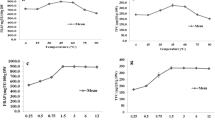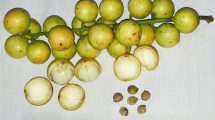Abstract
The response surface methodology (RSM) and the central composite rotatable design were used to optimize the antioxidant extraction from apple flesh of a new cultivar (Rural Issues and Agricultural Research Institute of Santa Catarina (EPAGRI) m-58/07). The extraction conditions were optimized by measured antioxidant capacities from the ferric-reducing power (FRAP) and 1,1-diphenyl-2-picrylhydrazyl (DPPH) assays, and by the determination of total phenol content. The results showed that the most significant variable in the extraction procedure was solvent concentration. The optimal condition found was of 60 %, 5 mL/g, 30 °C, and 61 min for acetone aqueous solution, solvent to solid ratio, temperature, and time, respectively, resulting in optimal antioxidant capacities of 2,152.96 μmol TE/100 g DW by DPPH and 6,491.39 μmol Fe2+/100 g DW by FRAP essays, and total phenol amount of 485.62 mg GAE/100 g DW. The antioxidant capacity of EPAGRI m-58/07 was verified to be substantially higher than other cultivars commercially available.




Similar content being viewed by others
References
Almeida MMB, Sousa PHM, Arriaga AMC, Prado GM, Magalhães CEC, Maia GA, Lemos TLG (2011) Bioactive compounds and antioxidant activity of fresh exotic fruits from northeastern Brazil. Food Res Int 44:2155–2159
Auta M, Hameed BH (2011) Optimized waste tea activated carbon for adsorption of Methylene Blue and Acid Blue 29 dyes using response surface methodology. Chem Eng J 175:233–243
Benzie IFF, Strain JJ (1996) The ferric reducing ability of plasma (FRAP) as a measure of “antioxidant power”: the FRAP assay. Anal Biochem 239:70–76
Bezerra MA, Santelli RE, Oliveira EP, Villar LS, Escaleira LA (2008) Response surface methodology (RSM) as a tool for optimization in analytical. Talanta 76:965–977
Brand-Williams W, Cuvelier ME, Berset C (1995) Use of a free radical method to evaluate antioxidant activity. Food Sci Technol-LEB 28:25–30
Budini R, Tonelli D, Girotti S (1980) Analysis of total phenols using the Prussian blue method. J Agric Food Chem 28:1236–1238
Çam M, Kjersti A (2010) Optimization of extraction of apple pomace phenolics with water by response surface methodology. J Agric Food Chem 58:103–9111
Cheng VJ, Bekhit AEA, McConnell M, Mros S, Zhao J (2012) Effect of extraction solvent, waste fraction and grape variety on the antimicrobial and antioxidant activities of extracts from wine residue from cool. Food Chem 134:474–482
Drogoudi PD, Pantelidis G (2011) Effects of position on canopy and harvest time on fruit physico-chemical and antioxidant properties in different apple cultivars. Sci Hortic 129:752–760
Drogoudi PD, Michailidis Z, Pantelidis G (2008) Peel and flesh antioxidant content and harvest quality characteristics of seven apple cultivars. Sci Hortic 115:149–153
Eberhardt MV, Lee CY, Liu RH (2000) Nutrition–antioxidant activity of fresh apples. Nature 405:903–904
Gan CY, Latiff AA (2011) Optimisation of the solvent extraction of bioactive compounds from Parkia speciosa pod using response surface methodology. Food Chem 124:1277–1283
García YD, Valles BS, Lobo AP (2009) Phenolic and antioxidant composition of by-products from the cider industry: apple pomace. Food Chem 117:731–738
Jayaprakasha GK, Singh RP, Sakariah KK (2001) Antioxidant activities of grape seed (Vitis vinifera) extracts on peroxidation models in vitro. Food Chem 73:285–290
Karacabey E, Mazza G (2010) Optimisation of antioxidant activity of grape cane extracts using response surface methodology. Food Chem 119:343–348
Komes D, Horžić D, Belščak A, Ganić KK, Vulić I (2010) Green tea preparation and its influence on the content of bioactive compounds. Food Res Int 43:167–176
Liyana-Pathirana C, Shahidi F (2005) Optimization of extraction of phenolic compounds from wheat using response surface methodology. Food Chem 93:47–56
Markham KR (1982) Techniques of flavonoid identification. Academic, London
Markom M, Hasan M, Daud WRW, Singh H, Jahim JM (2007) Extraction of hydrosable tannins from Phyllanthus niruri Linn. Effects of solvents and extraction methods. Separ Purif Technol 52:487–496
Minussi RC, Rossi M, Bologna L, Cordi L, Rotilio D, Pastore GM, Durán N (2003) Phenolic compounds and total antioxidant potential of commercial wines. Food Chem 82:409–416
Montgomery DC (2001) Design and analysis of experiments, 5th edn. Wiley, New York
Myers RH, Montgomery DC (2002) Response surface methodology: process end product optimization using designed experiments, 2nd edn. Wiley, New York
Naczk M, Shahidi F (2004) Extraction and analysis of phenolics in food: review. J Chromatogr A 1054:95–111
Ou B, Huang D, Hampsch-Woodill M, Flanagan JA, Deemer EK (2002) Analysis of antioxidant activities of common vegetables employing oxygen radical absorbance capacity (ORAC) and ferric reducing antioxidant power (FRAP) assays: a comparative study. J Agric Food Chem 50:3122–3128
Ozsoy N, Can A, Yanardag R, Akev N (2008) Antioxidant activity of Smilax excelsa L. leaf extracts. Food Chem 110:571–583
Prasad KN, Hassan FA, Yang B, Kong KW, Ramanan RN, Azlan A, Ismail A (2011) Response surface optimisation for the extraction of phenolic compounds and antioxidant capacities of underutilised Mangifera pajang Kosterm. peels. Food Chem 128:1121–1127
Pompeu DR, Silva EM, Rogez H (2009) Optimisation of the solvent extraction of phenolic antioxidants from fruits of Euterpe oleracea using response surface methodology. Bio Resour Technol 100:6076–6082
Pulido R, Bravo L, Saura-Calixto F (2000) Antioxidant activity of dietary polyphenols as determined by a modified ferric reducing/antioxidant power assay. J Agric Food Chem 48:3396–3402
Roginsky V, Lissi EA (2005) Review of methods to determine chain-breaking antioxidant activity in food. Food Chem 92:235–254
Rusak G, Komes D, Likic S, Horzic D, Kovac M (2008) Phenolic content and antioxidative capacity of green and white tea extracts depending on extraction conditions and the solvent used. Food Chem 110:852–858
Singleton VL, Rossi JA (1965) Colorimetric of total phenolics with phosphomolybdic-phosphotungstic acid reagents. Am J Enol Viticult 16:144–146
Song Y, Yao Y, Zhai H, Du Y, Chen F, Shu-wei W (2007) Polyphenolic compound and the degree of browning in processing apple varieties. Agr Sci China 6:607–612
Suárez B, Álvarez AL, García YD, del Barrio G, Lobo AP, Parra F (2010) Phenolic profiles, antioxidant activity and in vitro antiviral properties of apple pomace. Food Chem 120:339–342
Sun Y, Xu W, Zhang W, Hu Q, Zeng X (2011) Optimizing the extraction of phenolic antioxidants from kudingcha made from Ilex kudingcha C.J. Tseng by using response surface methodology. Sep Purif Technol 78:311–320
Tabaraki R, Nateghi A (2011) Optimization of ultrasonic-assisted extraction of natural antioxidants from rice bran using response surface methodology. Ultrason Sonochem 18:1279–1286
Tsao R, Yang R, Xie S, Sockovie E, Khanizadeh S (2005) Which polyphenolic compounds contribute to the total antioxidant activities of apple? J Agric Food Chem 53:4989–4995
Vaquero MJR, Sevalle LRT, Nadra MCM, Saad AMS (2010) Antioxidant capacity and antibacterial activity of phenolic compounds from Argentina herbs infusion. Food Control 21:779–785
Vargas AMM, Garcia CA, Reis EM, Lenzi E, Costa WF, Almeida VC (2010) NaOH-activated carbon from flamboyant (Delonix regia) pods: optimization of preparation conditions using central composite rotatable design. Chem Eng J 162:43–50
Vázquez G, Fernández-Agulló A, Gómez-Castro C, Freira MS, Antorrena G, González-Álvarez J (2012) Response surface optimization of antioxidants extraction from chestnut (Castanea sativa) bur. Ind Crop Prod 35:126–134
Vieira FGK, Borges GSC, Copetti C, Di Pietro PF, Nunes EC, Fett R (2011) Phenolic compounds and antioxidant activity of the apple flesh and peel of eleven cultivars grown in Brazil. Sci Hortic 128:261–266
Vieira FGK, Borges GSC, Copetti C, Di Pietro PF, Nunes EC, Fett R (2009) Physico-chemical and antioxidant properties of six apple cultivars (Malus domestica Borkh) grown in southern Brazil. Sci Hortic 122:421–425
Wijngaard HH, Ballay M, Brunton N (2012) The optimisation of extraction of antioxidants from potato peel by pressurized liquids. Food Chem 133:1123–1130
Wijngaard HH, Brunton N (2010) The optimisation of solid–liquid extraction of antioxidants from apple pomace by response surface methodology. J Food Eng 96:134–140
Wojdylo A, Oszmiański J, Laskowski P (2008) Polyphenolic compounds and antioxidant activity of new and old apple varieties. J Agric Food Chem 56:6520–6530
Wootton-Beard PC, Ryan L (2011) A beetroot juice shot is a significant and convenient source of bioaccessible antioxidants. J Funct Food 3:329–334
Acknowledgments
The authors acknowledge CAPES for financial support.
Author information
Authors and Affiliations
Corresponding author
Rights and permissions
About this article
Cite this article
Barizão, É.O., Martins, A.C., Ercoli, L. et al. Optimization of Antioxidant Compounds Extraction from Flesh of New Developed Apple Cultivar Using Response Surface Methodology. Food Anal. Methods 6, 1407–1415 (2013). https://doi.org/10.1007/s12161-012-9558-4
Received:
Accepted:
Published:
Issue Date:
DOI: https://doi.org/10.1007/s12161-012-9558-4




